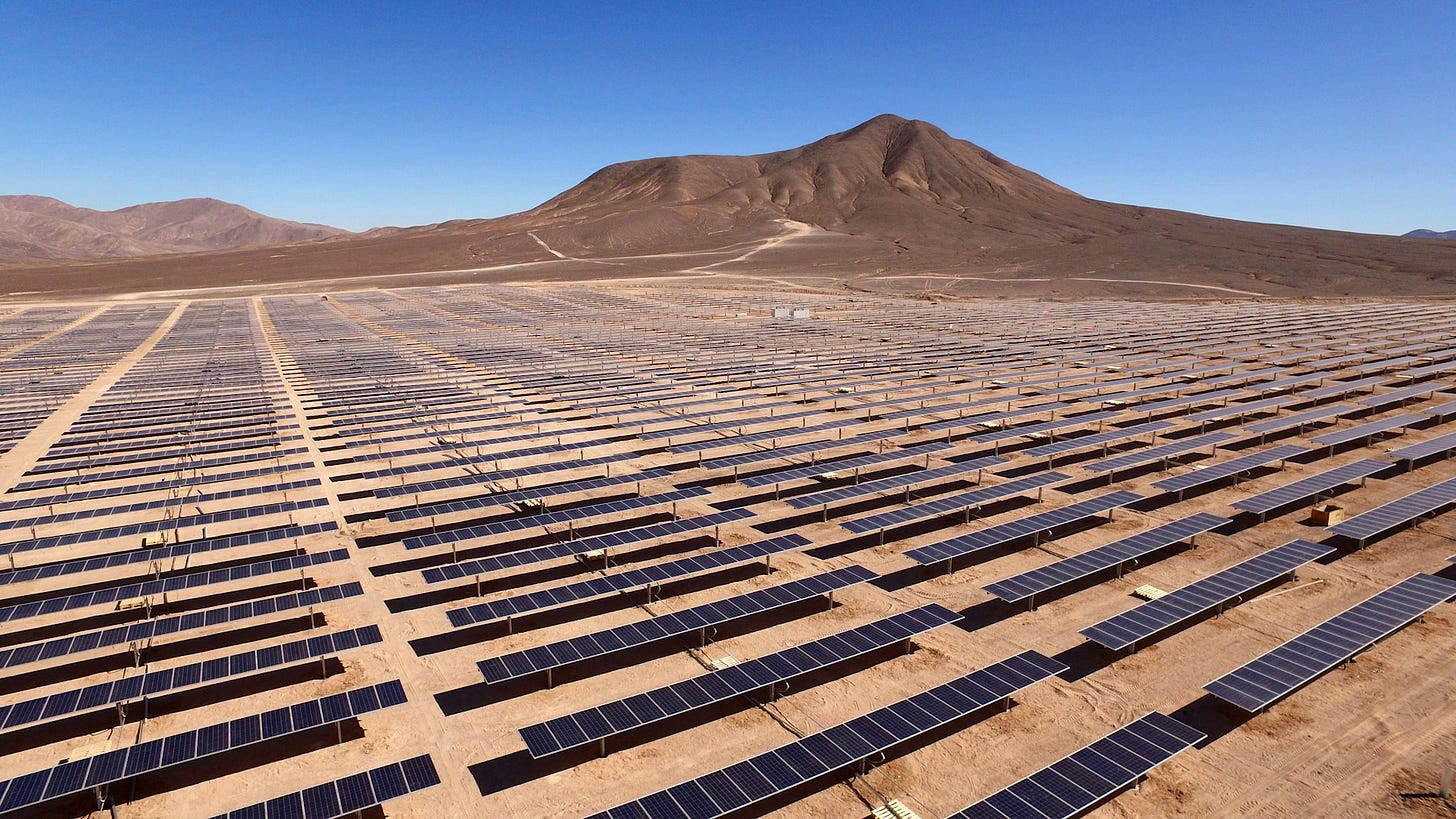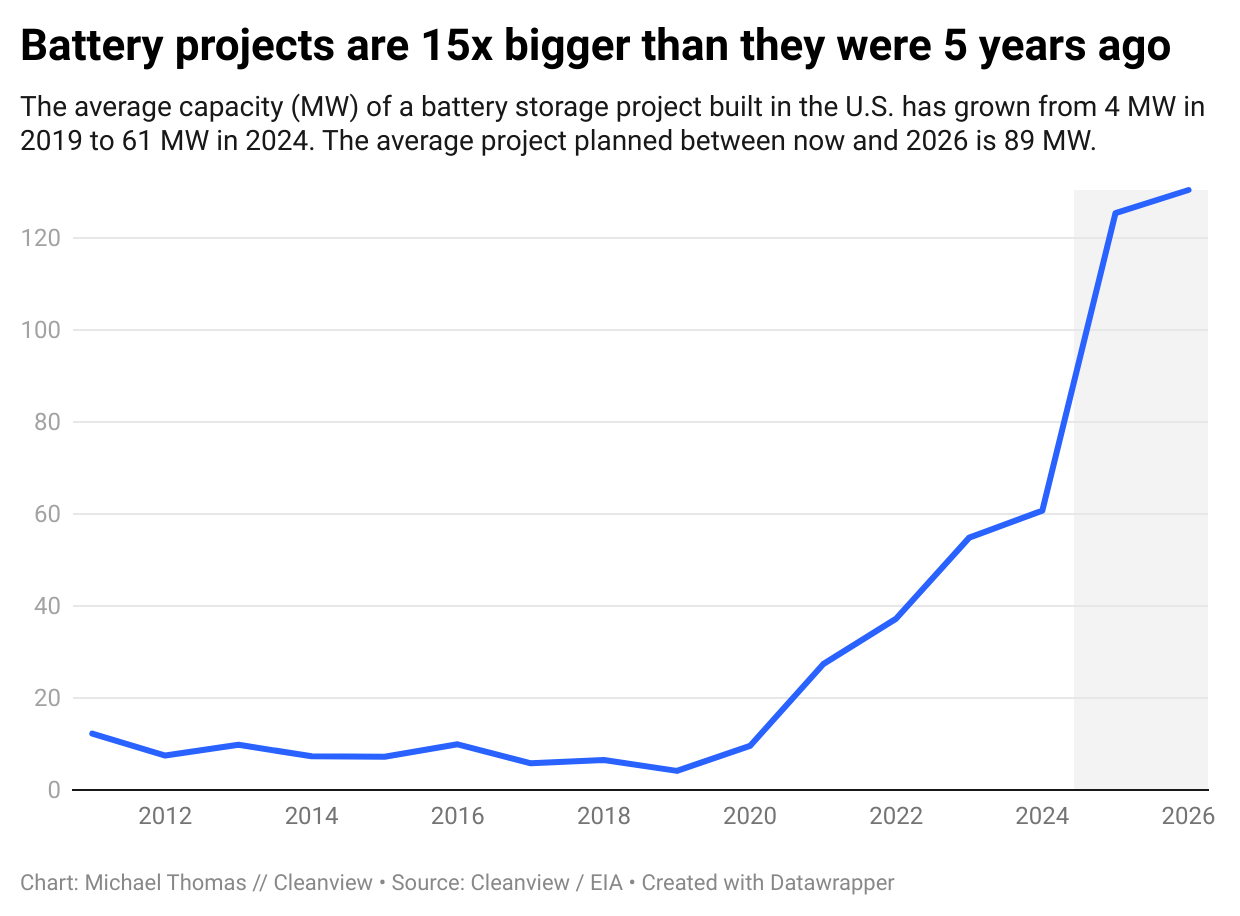The rise of the clean energy megaproject
Solar, wind and battery projects are getting very big
Over the last decade, clean energy capacity has exploded in the United States. The combined capacity of all utility-scale solar and wind projects around the country has grown from 75 gigawatts (GW) in 2014 to just over 240 GW today—a growth of more than 320%.
One reason for this growth is the rise of clean energy megaprojects.
In 2014, the average solar farm built in the U.S. had a capacity of 10 megawatts (MW)—big enough to power a few thousand homes. By comparison, the average solar farm built so far in 2024 has had a capacity of 65 MW, six times larger than the typical project built a decade ago.
There’s no sign that this growth is slowing either.
I analyzed data from interconnection queues—the waiting lines that developers have to sit in before connecting to the grid—around the country to see the average size of planned projects expected to come online over the next few years.
The average project slotted for 2025 is expected to have 125 MW of capacity, nearly twice as much as the average project built this year.
Another way to see this trend is by zooming in on specific projects. In 2013, First Solar built the Topaz Solar Farm outside of San Luis Obispo, California. At the time it was one of the largest solar farms in the country. The first phase of the project completed in June 2013 had a capacity of 151 MW, enough to power tens of thousands of Californian homes.
Last year, the largest project built in the United States—the 577 MW Fox Squirrel solar farm in Ohio—was nearly four times as large. This project wasn’t an outlier either. In 2023, there were 42 solar farms that had more capacity than the largest project built a decade ago. Some of these projects, like Fox Squirrel, can power hundreds of thousands of homes.
Solar farms aren't the only clean energy projects that are getting bigger. Over the last two decades, wind projects have also steadily risen in size and capacity.
In 2005 the average wind farm built in the United States had a capacity of about 70 MW. Last year, the average project came online with 200 MW of capacity, nearly three times as much.
Here, too, the trend is only likely to continue. Wind projects expected to come online between now and 2026 will have a capacity of 220 MW according to the interconnection queue data I analyzed.
One reason these projects are expected to grow in size is because, after decades of building solely on land, developers in the United States are finally building offshore wind farms. Some of these projects, located on the East Coast, will be measured not in megawatts but in gigawatts (that’s 1,000 MW). In Virginia, Dominion Energy recently started building one such project—its $10 billion, 2.6 GW Coastal Virginia Offshore Wind.
New transmission infrastructure is also making it possible to build larger wind projects in America.
The regions in the country with the highest wind speeds are mostly located far from population centers and cities that consume power. This presents a challenge to developers who need to sell the electricity they produce. For more than a decade, developers and clean energy advocates have been trying—and mostly failing—to build large-scale transmission projects to connect wind resources to cities. But that’s finally starting to change.
Two of the largest wind farms currently under construction will be made possible by massive transmission lines stretching hundreds of miles.
In Wyoming, the 3.5 GW Chokecherry and Sierra Madre Wind project will produce power and send it more than 700 miles to Arizona, Nevada, and California via the TransWest Express transmission line. Another 3.5 GW project under construction in New Mexico—SunZia Wind—will send power 500 miles to Arizona and California.
While transmission lines are making it possible to send power through space, another fast-growing technology is enabling clean energy to travel through time: battery storage.
As I wrote in a story last year, the plummeting cost of lithium-ion batteries has led to a surge in storage projects in places with high renewable energy penetration like California and Texas. These batteries have quickly gone from providing niche grid services like frequency regulation to storing large amounts of power and supplying energy at times of peak demand.
As the role of batteries has shifted, the average project size has risen dramatically. Just five years ago, the average battery storage project in America had a peak capacity of 4 MW. The average battery project that has come online this year has had 61 MW of peak capacity.
As in the case of solar and wind, this trend is expected to continue. Between now and 2026, the average battery project is expected to have 89 MW of peak capacity.
Looking at the largest storage projects built five years ago compared to the largest projects built in 2023, the trend of bigger and bigger batteries becomes even more clear.
In 2019, Key Capture Energy built the year’s largest battery project 30 miles north of Albany, New York. At its peak, the battery could provide 20 MW of power.
Last year, the largest battery built—a 350 MW storage project at Moss Landing in Monterey, California—had 17 times more peak capacity than the largest project built in 2019. And that was the third phase of the project. The entire Moss Landing project has a combined capacity of 750 MW (and 3,000 MWh).
There are multiple reasons why developers are building larger clean energy and storage projects. Financing, interconnection queue processes, permitting, and industry dynamics are all playing a role. But one of the main reasons has to do with cost: Building big solar, wind, and battery projects enables economies of scale.
The average 5 to 20 MW solar project cost $1.26 per watt in 2022, according to an analysis by Lawrence Berkeley National Laboratory (LBNL). By comparison, large-scale projects—those ranging from 100 to 400 MW—cost $0.82 per watt. In other words, building a big project can get you 46% more watts of capacity for every dollar spent. (Researchers have found similar economies of scale in utility-scale wind and battery projects).
Considering the role that prices play in a capitalist economy and the huge investment that it will take to reach net zero, the rise of the clean energy megaproject is probably a good thing.
Explore the data in this story
I did all the analysis for this story using Cleanview, the platform I built to track clean energy projects and trends. Check out Cleanview’s Free Project Explorer here or sign up for Cleanview Pro by clicking the link below.







